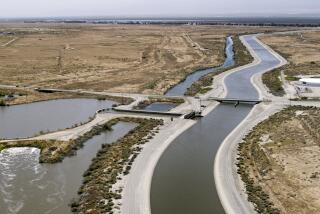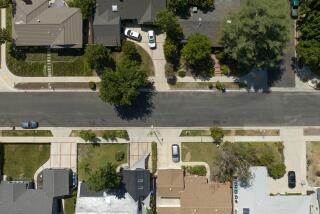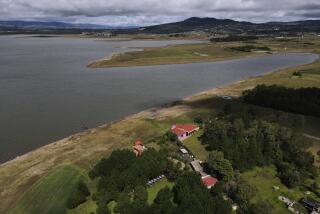Three S.D. Districts Placed on Strict Water-Use Rules : Emergency: Break in major pipeline triggers Stage 4 alert; outdoor watering and washing of cars forbidden.
SAN DIEGO — Several hundred thousand residents south and east of San Diego were admonished Saturday to reduce their water consumption by at least half--and for some neighborhoods to brace for the possibility of intermittent water stoppages--because of a break in one of the five main aqueducts that bring imported water to San Diego County.
Three water districts that serve suburban cities and rural neighborhoods declared Stage 4 water emergencies, banning outdoor watering and car washing and asking customers to cut back on domestic water use indoors.
Water officials were also turning off water meters that serve crop irrigation lines and construction sites.
Officials said the rupture of the 84-inch aqueduct--which normally pours 70-million gallons of water daily into the area--might not be repaired until Friday. Workers are awaiting a replacement 20-foot steel pipe section now being fabricated in Los Angeles. “And once it’s delivered, we’ll work around the clock to get it in,” said Lester Snow, general manager of the San Diego County Water Authority, which sells wholesale water to the county’s individual public water districts.
He said cause of Friday’s break in the reinforced concrete pipe, situated in the Scripps Ranch area just south of the Miramar Reservoir, was still unknown Saturday.
Snow said lessons are being learned from the incident, such as how San Diego might fare if an earthquake ruptured one or more of the five pipelines that bring imported water into San Diego.
“This is a good illustration of what we’d have to do if we had an earthquake--by asking the public to immediately reduce its water consumption and by asking the various water agencies to share their water through interconnections,” he said.
While officials on Saturday said they couldn’t accurately measure to what degree customers were reducing water consumption, they said the cooperative interconnections between the agencies were operating well.
Among those affected by the waterline break were residents of the cities of Santee, El Cajon, La Mesa and Lemon Grove, and the unincorporated communities of Rancho San Diego, Spring Valley, Lakeside, Alpine and Otay alongside the U.S.-Mexico border.
Within the city of San Diego itself, only residents in the northern suburb of Rancho Bernardo might experience a drop in water pressure, Snow said.
While Snow said there should be no serious water shortages if customers cut back on water and the affected agencies are able to buy water from neighboring districts--as they were doing on Saturday--other water officials still made dire pronouncements.
“We’re at a Stage 4 alert,” said Leslie Melenchuk, spokesperson for the Padre Dam Municipal Water District. “And there is no Stage 5. This is as bad as it gets.”
Said Charlie Cassens, spokesman for the Otay Water District, the hardest hit: “We have enough water in our storage tanks to keep us until Wednesday, but we could run out of water, unless we get every customer to cut back to only the most essential water use.
“There may be some areas in our district that will experience lower water pressure, and there is the possibility of intermittent interruptions in our water service as we do some creative ‘valving’ to keep our reservoirs from going dry.”
Both the Otay and Padre Dam Municipal Water Districts were buying water from the Helix Water District, which also relied on the broken water line but which has several weeks’ worth of water stored in its Lake Jennings reservoir.
“We’ll have plenty of water--if the weather stays cool and people are cooperative,” said Shirley Massie, spokeswoman for the Helix Water District. “We’re just scurrying about, trying to get water to the other two districts.”
On Saturday, Helix was supplying 20-million gallons of water to the Padre Dam district, accounting for about half it’s daily average consumption, and between 6- and 8-million gallons of water to Otay, accounting for about 25% of its daily average water consumption.
The Otay district was also drawing some water from the city of San Diego.
But, sitting literally at the end of the water pipeline from Northern California to the Mexican border, the Otay district officials said they weren’t bluffing when asking customers to cut back.
“We’re trying to get the word out to everybody that this is no drill, or the result of the drought or any political maneuvering,” Cassens said. “This is an actual, physical break in a main artery that brings imported water to San Diego County. This is most certainly an example of what could happen to the region in an earthquake.”
Water district employees were called in to work on Saturday--and most of them were sent right back out to area shopping centers, where they put flyers on cars that read: “WATER EMERGENCY.”
Noting that water supplies are limited and that mandatory restrictions are being enforced, the flyer ended with this warning:
“Water use must be cut back 50% to 75% until further notice!!”
Said Cassens, “If there’s a fire, we could be sucking dry tanks in no time.”
He said enforcement officers were patrolling the district to look for water-wasting scofflaws, and he called on residents to take action if they see people not taking the matter seriously.
“Hopefully, people will take this seriously and spread the word. If they see someone wasting water in any way, shape or form, we hope they’ll try to educate them not to waste it. It’s all our water, and nobody has more rights to it than anyone else.”
Districts Restricting Water Usage
Padre Dam Municipal
Water District:
Santee, Alpine, Crest, Harbison Canyon, Blossom Valley, Dehesa, Flynn Springs and parts of El Cajon and Lakeside. Additionally, Padre Dam sells water to the Lakeside and Riverview Water Districts, which serve Lakeside.
Helix Water
District:
La Mesa, Lemon Grove, Spring Valley and parts of El Cajon.
Otay Water
District:
Rancho San Diego, Jamul, parts of Spring Valley, La Presa, parts of El Cajon, eastern part of Chula Vista, south to the Mexican border.
More to Read
Sign up for Essential California
The most important California stories and recommendations in your inbox every morning.
You may occasionally receive promotional content from the Los Angeles Times.









